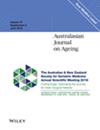Analgesic and adjuvant co-prescribing in Australian and Finnish residential care homes
Abstract
Objective
To explore the co-prescribing of analgesic and/or adjuvant medications among residents of Australian and Finnish residential care homes.
Method
Secondary cross-sectional analyses of prescribing data from residents of 12 Australian residential care homes in 2019 and 53 Finnish nursing homes and assisted living facilities in 2017–2018. Demographic characteristics and medication data were extracted from medical records and medication administration charts. Co-prescribing was defined as more than one analgesic (acetaminophen, non-steroidal anti-inflammatory drugs and opioids) and/or adjuvant (gabapentinoids, tricyclic antidepressants and duloxetine) medication prescribed for regular administration.
Results
Overall, 550 Australian residents (89 [IQR 84–92] years; 73% females) and 2423 Finnish residents (84 [IQR 65–103] years; 74% females) were included. Of 416 Australian residents prescribed any regular analgesic or adjuvant, 181 (44%) were prescribed two or more, including 66 (16%) who were prescribed three or more. Of 1406 Finnish residents prescribed any regular analgesic or adjuvant, 469 (33%) were prescribed two or more, including 87 (6%) who were prescribed three or more. Acetaminophen was co-prescribed to more than 75% of Australian and 43% of Finnish residents prescribed other analgesics or adjuvants. Of 61 Australian residents and 186 Finnish residents prescribed gabapentinoids, 38 (62%) and 86 (46%) were co-prescribed opioids. Opioids were co-prescribed to 59%–83% of Australian and 25%–46% of Finnish residents prescribed adjuvants.
Conclusions
Analgesic and adjuvant co-prescribing was more prevalent for Australian than Finnish residents, which was largely driven by acetaminophen co-prescribing to more than three quarters of analgesic or adjuvant users in Australia. Central nervous system-active polypharmacy arising from high rates of adjuvant and opioid co-prescribing warrants further attention.


 求助内容:
求助内容: 应助结果提醒方式:
应助结果提醒方式:


